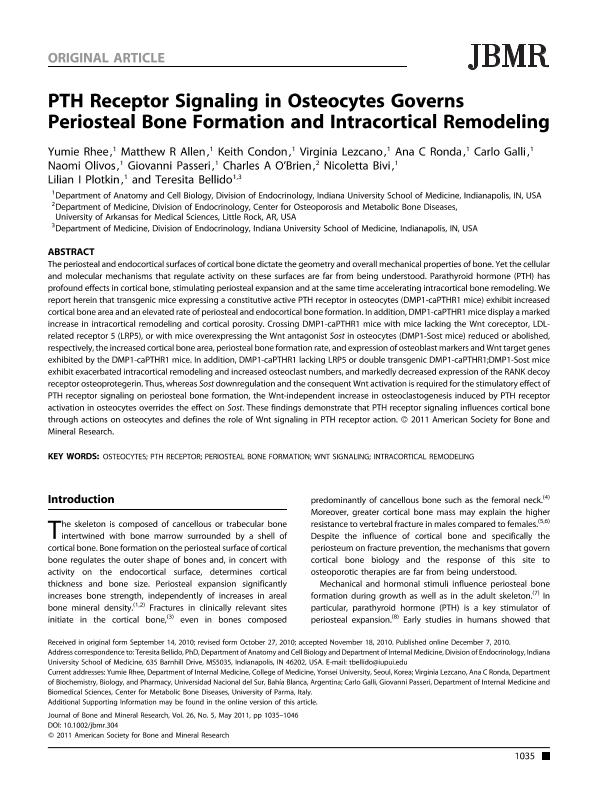Artículo
PTH receptor signaling in osteocytes governs periosteal bone formation and intracortical remodeling
Rhee, Yumie; Allen, Matthew R; Condon, Keith; Lezcano, Virginia Alicia ; Ronda, Ana Carolina
; Ronda, Ana Carolina ; Galli, Carlo; Olivos, Naomi; Passeri, Giovanni; O'Brien, Charles A; Bivi, Nicoletta; Plotkin, Lilian I; Bellido, Teresita
; Galli, Carlo; Olivos, Naomi; Passeri, Giovanni; O'Brien, Charles A; Bivi, Nicoletta; Plotkin, Lilian I; Bellido, Teresita
 ; Ronda, Ana Carolina
; Ronda, Ana Carolina ; Galli, Carlo; Olivos, Naomi; Passeri, Giovanni; O'Brien, Charles A; Bivi, Nicoletta; Plotkin, Lilian I; Bellido, Teresita
; Galli, Carlo; Olivos, Naomi; Passeri, Giovanni; O'Brien, Charles A; Bivi, Nicoletta; Plotkin, Lilian I; Bellido, Teresita
Fecha de publicación:
05/2011
Editorial:
American Society for Bone and Mineral Research
Revista:
Journal of Bone and Mineral Research
ISSN:
0884-0431
Idioma:
Inglés
Tipo de recurso:
Artículo publicado
Clasificación temática:
Resumen
The periosteal and endocortical surfaces of cortical bone dictate the geometry and overall mechanical properties of bone. Yet the cellular and molecular mechanisms that regulate activity on these surfaces are far from being understood. Parathyroid hormone (PTH) has profound effects in cortical bone, stimulating periosteal expansion and at the same time accelerating intracortical bone remodeling. We report herein that transgenic mice expressing a constitutive active PTH receptor in osteocytes (DMP1-caPTHR1 mice) exhibit increased cortical bone area and an elevated rate of periosteal and endocortical bone formation. In addition, DMP1-caPTHR1 mice display a marked increase in intracortical remodeling and cortical porosity. Crossing DMP1-caPTHR1 mice with mice lacking the Wnt coreceptor, LDL-related receptor 5 (LRP5), or with mice overexpressing the Wnt antagonist Sost in osteocytes (DMP1-Sost mice) reduced or abolished, respectively, the increased cortical bone area, periosteal bone formation rate, and expression of osteoblast markers and Wnt target genes exhibited by the DMP1-caPTHR1 mice. In addition, DMP1-caPTHR1 lacking LRP5 or double transgenic DMP1-caPTHR1;DMP1-Sost mice exhibit exacerbated intracortical remodeling and increased osteoclast numbers, and markedly decreased expression of the RANK decoy receptor osteoprotegerin. Thus, whereas Sost downregulation and the consequent Wnt activation is required for the stimulatory effect of PTH receptor signaling on periosteal bone formation, the Wnt-independent increase in osteoclastogenesis induced by PTH receptor activation in osteocytes overrides the effect on Sost. These findings demonstrate that PTH receptor signaling influences cortical bone through actions on osteocytes and defines the role of Wnt signaling in PTH receptor action. © 2011 American Society for Bone and Mineral Research.
Archivos asociados
Licencia
Identificadores
Colecciones
Articulos(CCT - BAHIA BLANCA)
Articulos de CTRO.CIENTIFICO TECNOL.CONICET - BAHIA BLANCA
Articulos de CTRO.CIENTIFICO TECNOL.CONICET - BAHIA BLANCA
Citación
Rhee, Yumie; Allen, Matthew R; Condon, Keith; Lezcano, Virginia Alicia; Ronda, Ana Carolina; et al.; PTH receptor signaling in osteocytes governs periosteal bone formation and intracortical remodeling; American Society for Bone and Mineral Research; Journal of Bone and Mineral Research; 26; 5; 5-2011; 1035-1046
Compartir
Altmétricas



